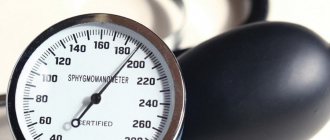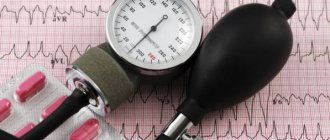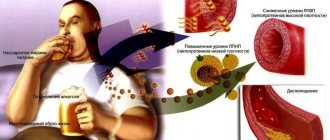15.03.2018
Last modified: December 26th, 2020 at 06:27 pm
A person's blood pressure depends on a number of factors and can decrease or increase for various reasons. Determining the normal limit is quite difficult, since optimal indicators depend on age, gender, condition and characteristics of the body. The “gold standard” is considered to be 120 to 80, but they are observed in a small number of people, while others deviate in one direction or another. What does pressure 150 to 70 mean, and does it need to be treated?
Causes of arterial hypertension
It can develop due to a number of prerequisites, which include:
- cardiovascular diseases, kidney pathologies;
- negative environmental influences (atmospheric pressure surges, high temperature and humidity);
- excessive physical or emotional stress;
- chronic fatigue syndrome;
- sleep disorders, insomnia;
- incorrect lifestyle, bad habits;
- unhealthy diet, abuse of caffeine and other stimulants;
- obesity, overweight;
- age-related changes in the body.
The genetic factor plays an important role in the development of hypertension; it is especially often transmitted through the female line, and with a family history, high blood pressure can be observed in young people.
Attention: the diagnosis of “hypertension” is made only by a doctor after collecting the patient’s history and complaints, as well as monitoring pressure indicators over time. You cannot self-diagnose and treat high blood pressure.
In what cases do we talk about pathology?
Unfortunately, there are more pathological causes and they are much more common. The following diseases are presented:
- Pathologies of the excretory system organs. Most often, the kidneys are affected, and due to insufficient renin synthesis, the cardiovascular system is affected. The body does not receive enough hypertensive stimulation, the lower pressure is 50-55 and is constantly at these levels. More often, a similar picture is observed with typical hypotension; isolated types of the process are less common.
- Diseases of the adrenal glands. The so-called secondary or primary hypocortisolism or Addison's syndrome. Associated with insufficient production of cortisol and corticosteroids in general.
- Diseases of the thyroid gland based on the type of insufficient synthesis of thyroid substances: T3, T4. Also partly related to this process are pituitary problems, when there is not enough TSH, which stimulates the synthesis of specific thyroid-stimulating hormones.
Hypothyroidism is difficult to “overlook”; a lot of symptoms are typical for it. However, you cannot do without additional consultation with an endocrinologist.
- Stroke. The early rehabilitation period is unpredictable, and both an increase and a decrease in tonometer readings is possible. Hypotension occurs more often.
This is normal at first; a lower pressure of 55 means that the body is adapting and restoring its activity.
But if there is a stable drop in blood pressure, the patient needs to be checked again.
- Heart attack. Diastolic pressure below 60 is associated with the same adaptation mechanisms. But it's not that simple.
Perhaps secondary coronary heart disease begins and the organ is not able to provide blood even to itself.
It can all end in relapse and death. Each subsequent heart attack is more dangerous than the previous one.
- Brain diseases of traumatic origin. A temporary drop in diastolic pressure occurs during concussions of cerebral structures and the formation of hematomas. Diagnosis is necessary immediately. It is not known what the patient is dealing with.
- A lower pressure of 55-60 is possible with diseases of the musculoskeletal system and muscle structures in the neck.
Including vertebrobasilar insufficiency, myositis, fibrosis, osteochondrosis, hernia of the cervical spine. Most common.
Impairment of cerebral circulation, regulation of circadian rhythms and blood pressure develops.
- Anemic processes associated with constant minimal blood loss (for example, with a stomach ulcer) and other factors. Including nutritional ones.
The classic version of anemia is a decrease in hemoglobin levels due to insufficient iron intake from food. Hence all the symptoms and a stable decrease in blood pressure, sometimes uneven.
- Heavy bleeding. For example, with tuberculosis, childbirth, pathological menstrual cycle. Correction is required urgently. It is often a matter of life and death.
The patient can create pathological changes in the cardiovascular system with his own hands: smoking, alcohol abuse, unhealthy diet.
All this affects blood pressure levels in the short and long term.
Symptoms of hypertension
In the first stages, the pathology is often asymptomatic, and a slight increase in pressure can only be determined after measuring blood pressure. Over time, the disease progresses, and in addition to large numbers on the tonometer, a person experiences the following symptoms:
- headaches, dizziness;
- increased anxiety, mood swings;
- noise in ears;
- loss of appetite, nausea;
- “flies” and a veil before the eyes;
- pain in the heart area, rapid pulse (above 150 or more beats per minute);
- dyspnea.
Important information: How to lower your blood pressure before a medical examination?
As a rule, signs of hypertension are felt especially strongly when there is a significant difference between systolic and diastolic pressure. So, with a reading of 150 over 50, a person will have a stronger headache than with a blood pressure of one hundred thirty over seventy. A difference of 30-50 mmHg is considered normal, and a large gap usually indicates the presence of serious pathologies.
Important: elevated upper pressure and low lower pressure (150 to 60, 150 to 70) may mean that a person has tuberculosis, which is accompanied by dysfunction of the digestive tract and gall bladder. In such a situation, pathologies of the kidneys and cardiovascular system should also be excluded.
Is this blood pressure normal?
A blood pressure of 140 over 60 (in both the elderly and young) cannot be considered normal. It does not fit any of the normal criteria for assessing blood pressure:
- the systolic indicator exceeds the norm;
- diastolic - below normal;
- pulse pressure exceeds the maximum permissible value of 60 mm.
A blood pressure of 140 over 60 may also be called isolated systolic hypertension. In such a situation, under the influence of various neurohumoral processes, an increase in blood pressure inside the arteries occurs only during cardiac contraction.
According to statistics, no more than 15% of the population over 60 years of age live with normal blood pressure. All others are diagnosed with high blood pressure. Even if a person has been hypotensive all his life, in old age he will suffer from hypertension.
What does a high pulse difference mean?
A high pulse difference can be a sign of various pathological conditions. In addition, it can be observed during physical and psycho-emotional stress. Diseases in which a blood pressure of 140 over 60 and a pulse of 60 will be observed include:
It is worth noting that with such diseases, blood pressure levels will be constant. If there is an increase in pressure from normal to such indicators, then this will most likely indicate hypertension.
What are the risks?
With a large pulse difference and isolated systolic hypertension, there is a risk of stroke and myocardial infarction. In addition, there is insufficient blood supply to the kidneys in the periphery, and there is also a risk of dilation of the heart chambers.
The greatest likelihood exists for the development of heart pathologies. Thus, a number of studies were conducted that showed the relationship between high pulse pressure and the occurrence of heart disease.
Hypertension in old age
High blood pressure accompanies most people after reaching 60 years of age; indicators can reach 150 mmHg and higher. Such values are considered normal if a person does not experience unpleasant symptoms, but since in old age the risk of complications is much higher, mature people diagnosed with arterial hypertension are usually prescribed appropriate medications. Breathing exercises and light physical activity have a good effect on the body.
What to do if the pressure is 150 to 60?
So, you measured the pressure and the tonometer showed 150/60 mm. rt. Art. This indicator indicates that you have high blood pressure, regardless of age or gender. What to do in this case?
Determining the exact cause of high blood pressure
Physical activity
The first and most important step is to accurately determine the causes of hypertension. If the pressure has increased as a result of active physical activity, then it is necessary to rest and minimize physical activity. If hypertension was preceded by psycho-emotional stress, it is necessary to get rid of the cause of stress and, if possible, use organic sedatives.
If the pressure is constant, then this indicates the development of essential hypertension, which develops as a result of a number of endogenous causes. In this case, the best course of action is to undergo a diagnosis from a doctor and determine the most effective treatment method.
Hypertension during pregnancy
During the period of bearing a child, all processes in a woman’s body are activated, the volume of circulating blood increases, which affects blood pressure values. Most often, during pregnancy it decreases, but sometimes an increase can be observed, which is not accompanied by discomfort.
A slight increase in blood pressure is considered normal, but levels of 150x70 can have serious consequences for the child. In this case, it is better to seek medical help as soon as possible - sometimes hospitalization is required to preserve the health of the mother and fetus of a pregnant woman.
Low pressure
If the condition has sharply worsened and the tonometer displays 100/60, it is time to immediately consult a doctor. A course of therapy will be required to restore health.
While a person is young, he does not think about why low blood pressure is sometimes recorded. Many consider the condition to be normal if there are no side signs or discomfort. However, over the years the situation has become critical. The consequence will be orthostatic hypotension. Blood pressure drops when an elderly person changes body position. The jump down often happens in the morning, as soon as old people get out of bed. The body goes from a horizontal state to a vertical one.
Causes of low blood pressure
In older people, low blood pressure is often congenital, then you just need to control your own condition. However, there are reasons for low blood pressure in older people, leading to hypotension:
- Unbearable physical activity;
- Insufficient caloric nutrition, hunger;
- Blood loss;
- Previous infections;
- Poisoning.
Dehydration leads to a decrease in blood pressure. Even moving to another region, where the climate is radically different, affects pressure indicators.
Symptoms of low blood pressure
It is not difficult to notice low blood pressure. The symptoms are quite expressive:
- Nausea;
- Weakness, lethargy;
- Headache;
- Apathy;
- Memory lapses;
- Fainting attacks;
- Daytime sleepiness.
Recommendations for low blood pressure
To prevent sudden falls and fainting caused by hypotension, you need to have information about what to do. There are many proven ways to raise blood pressure in an elderly person. This includes:
- Drink 50 g of cognac (can be added to coffee drink, tea);
- Eat a piece of dark chocolate;
- Dissolve a pinch of salt;
- Take medications: Citramon, Aspirin or Papazol;
- Eat something salty.
For the purpose of prevention and for raising blood pressure, it is recommended:
- Slowly get out of bed: first sit down, feel the state, then slowly get up;
- Avoid emotional overload;
- Prevent stressful situations;
- After waking up, drink a cup of instant coffee;
- Watch your diet, avoid diets and fasting.
By following basic recommendations, in old age you can learn to maintain both high and low blood pressure. Its indicator should be close to normal.
Why is hypertension dangerous?
Frequent increases in blood pressure to 140x80 can lead to serious consequences for the body. It leads to wear and tear of blood vessels and heart muscle, as well as impaired circulation in all organs, which causes numerous diseases, primarily pathologies of the kidneys, vision, and excretory system. In severe cases, hypertension leads to stroke (in common parlance, stroke) and heart attack - conditions that threaten not only health, but also human life.
Important information: High blood pressure
Attention: the risk of heart attack and stroke increases significantly when blood pressure levels are above 150, so measures should be taken as soon as possible to reduce the values.
Causes of increased pulse pressure
How dangerous a pressure of 150 to 60 is depends on the reasons leading to such a pathological change. Among the most common provoking factors are:
- Increased functioning of the heart muscle - blood is pushed into the vessels with double force. This condition is dangerous due to the development of muscle hypertrophy.
- Reduced elasticity of blood vessels. The level of diastolic pressure depends on the functioning of the kidneys; they produce a special enzyme, renin. It is this enzyme that is responsible for the correct and uninterrupted contraction and relaxation of blood vessels, regardless of external and internal influences. With insufficient production of renin, the vessels lose their natural tone, do not contract as they should, and this gradually leads to atherosclerosis.
- Emotional overload. This cause of increased PD can be dealt with using medications with a sedative effect.
- Age-related aging. With age, vascular tone inevitably decreases, and they stop responding to blood circulation as necessary.
- Anemia.
- Impaired functioning of the thyroid gland.
When identifying an increased difference between diastolic and systolic pressure, it is first necessary to exclude the most common causes of this pathology. Often the culprit for an increase in PP indicators is non-compliance with the technique of measuring blood pressure with a tonometer.
First aid
If the pressure is 150 to 70, it is best to go to a medical facility (especially if your health deteriorates significantly), but if this is impossible for some reason, you need to provide the person with first aid at home. The best option is to take a quick-acting antihypertensive drug - Andipal, Raunatin, Captopril. Do not forget that only adults can drink them if there are no contraindications after consulting a doctor. If you don’t have such medications at hand, Corvalol, Valocordin or any sedative will do - they slightly reduce blood pressure.
A common way to normalize blood pressure at home is regular cold water. You can dip your hands and feet in it up to the ankle level for 2-4 minutes, put a clean cloth moistened with cold water on the solar plexus area, or simply wash your face. Doctors argue about whether cold water can be used for high blood pressure, so it is necessary to monitor your well-being during procedures. If this option is not suitable, you can take a warm shower.
Important: you should lower your blood pressure at home carefully – a sharp drop is no less dangerous than an increase.
Therapy with a doctor
The doctor measures blood pressure, performs monitoring, and studies the medical history. If a patient takes medications, but for various reasons they do not help, a specialist will help adjust them.
Cyclomethiazide, Oxodoline, Indapamide, diuretics and sedatives are usually prescribed. Before using them, you must ensure that there are no contraindications.
It is especially important to clarify which medications can worsen the condition and further increase the pressure. If the problem appears for the first time, it is recommended to follow preventive measures.
The doctor may prescribe tests (blood, urine) and studies (ultrasound examination of the heart, blood vessels, kidneys) to check for diseases that cause hypertension.
You should definitely purchase a device to measure pressure and monitor the indicators. Perhaps they rise at a certain time of the day (for example, in the evening or in the morning). You should tell your doctor about this.
Treatment of hypertension
Therapy for this pathology is prescribed by a doctor and may consist of a number of drugs - alpha and beta blockers, diuretics and sedatives, calcium channel blockers and antitensive receptors. In addition, patients need to follow simple rules that will enhance the effect of medications and reduce the risk of complications:
- normalize your lifestyle, adhere to a daily routine;
- have a good rest;
- to refuse from bad habits;
- engage in light physical activity, spend more time in the fresh air;
- reduce the consumption of salt and sugar, as well as fatty and fried foods;
- include fresh vegetables and fruits in your diet (beets, pomegranates, and grapefruits are especially useful);
- exclude alcohol, coffee, sweet carbonated drinks, replacing them with herbal infusions of motherwort, chamomile, valerian, lemon balm.
It is strictly not recommended to treat hypertension on your own, as this will aggravate the patient’s condition and lead to dire consequences. An increase in pressure up to 150 over 70 can be a symptom of serious diseases and disorders in the body. To avoid unpleasant consequences, it is recommended to consult a doctor as soon as possible, strictly adhere to medical recommendations and lead a healthy lifestyle.
How to quickly lower blood pressure at home
If you urgently need to bring down high blood pressure as quickly as possible, a CAPOTENA tablet will help you (put the tablet under your tongue and quickly dissolve).
If, after you have swallowed one Capoten tablet, your blood pressure does not begin to decrease, count out 40 drops of Carvalol, mix with 50 grams of water and drink. (Carvalol, by itself, does not lower blood pressure, but calms the body’s nervous system, which helps lower blood pressure).
If your blood pressure continues to rise, take a capoten tablet every hour (up to 4 tablets per day (24 hours)).
There are folk remedies for lowering blood pressure without the use of drugs. There are many things you can do to keep your blood pressure at a normal level. Let's take a look at the various remedies that will help you in lowering your blood pressure quickly. These simple home remedies can eliminate the need for treatment, especially since none of them have any side effects. So: Changing the diet - in rapidly changing living conditions, people tend to eat more unhealthy foods. Most often these are foods containing salt, fat and cholesterol. This diet does more harm than good and leads to high blood pressure. In order to reduce blood pressure quickly, you need to reduce the amount of salt you consume. Don't eat fried foods. You should eat foods rich in potassium such as raisins, figs, apricots, bananas, etc. - They help balance the amount of sodium in the body. You should eat more fresh foods such as vegetables, fruits, whole grains, fish; Proper breathing – slow breathing helps you relax.
This calms the nervous system and lowers the heart rate. This is why you should do breathing exercises regularly to help you breathe properly. Any time you feel your blood pressure rise, go to a room where you can fully relax. Sit in a comfortable position and take short but deep breaths through your nose - this will immediately lower your blood pressure. Apart from this, you should try meditation, yoga, massage and should also make it a habit to rest throughout the day to keep your blood pressure under control. Even 15-20 minutes of rest will be enough for blood pressure problems to go away; Drink plenty of water – It is very important to drink 8 to 10 glasses of water every day to keep your blood pressure levels within normal limits. Water helps remove harmful toxins from the body, and therefore the overall health of the body improves; Give up bad habits - if you want your cardiovascular system to work smoothly, stop smoking and drinking alcohol, as this causes an increase in blood pressure. These habits seriously affect the absorption of nutrients in the digestive system. Low supply of nutrients leads to multiple health problems. Excessive smoking and drinking tend to damage arteries, causing high blood pressure.
If all of the above methods do not help you , contact a medical institution for qualified help. Do not forget that in some cases, high blood pressure can be a sign of the development of more serious diseases and, if they are not recognized in a timely manner, the consequences can be very sad.











